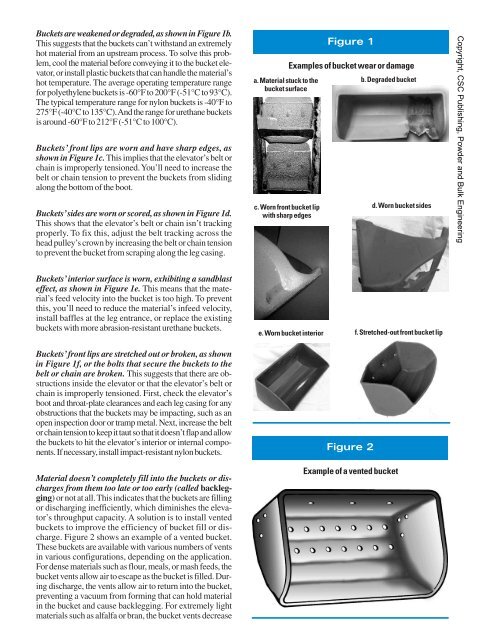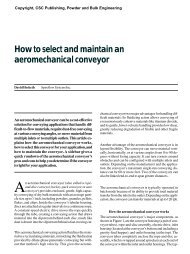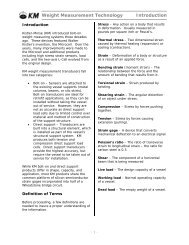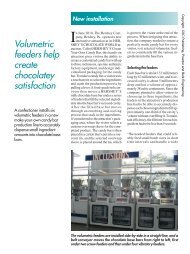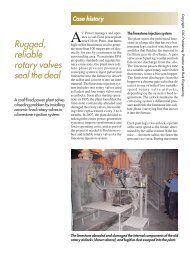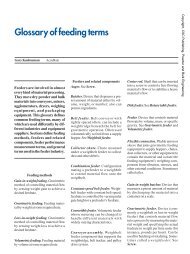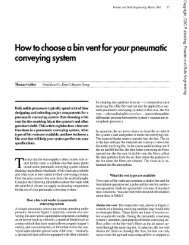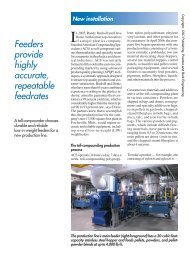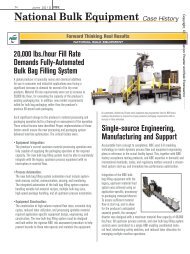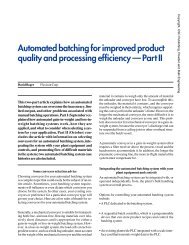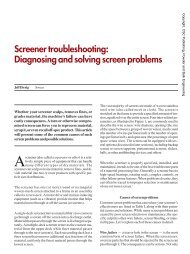Bucket elevator: Diagnosing and solving seven common problems
Bucket elevator: Diagnosing and solving seven common problems
Bucket elevator: Diagnosing and solving seven common problems
You also want an ePaper? Increase the reach of your titles
YUMPU automatically turns print PDFs into web optimized ePapers that Google loves.
<strong>Bucket</strong>s are weakened or degraded, as shown in Figure 1b.<br />
This suggests that the buckets can’t withst<strong>and</strong> an extremely<br />
hot material from an upstream process. To solve this problem,<br />
cool the material before conveying it to the bucket <strong>elevator</strong>,<br />
or install plastic buckets that can h<strong>and</strong>le the material’s<br />
hot temperature. The average operating temperature range<br />
for polyethylene buckets is -60°F to 200°F (-51°C to 93°C).<br />
The typical temperature range for nylon buckets is -40°F to<br />
275°F (-40°C to 135°C). And the range for urethane buckets<br />
is around -60°F to 212°F (-51°C to 100°C).<br />
<strong>Bucket</strong>s’ front lips are worn <strong>and</strong> have sharp edges, as<br />
shown in Figure 1c.This implies that the <strong>elevator</strong>’s belt or<br />
chain is improperly tensioned. You’ll need to increase the<br />
belt or chain tension to prevent the buckets from sliding<br />
along the bottom of the boot.<br />
<strong>Bucket</strong>s’ sides are worn or scored, as shown in Figure 1d.<br />
This shows that the <strong>elevator</strong>’s belt or chain isn’t tracking<br />
properly. To fix this, adjust the belt tracking across the<br />
head pulley’s crown by increasing the belt or chain tension<br />
to prevent the bucket from scraping along the leg casing.<br />
Figure 1<br />
Examples of bucket wear or damage<br />
a. Material stuck to the<br />
b. Degraded bucket<br />
bucket surface<br />
c. Worn front bucket lip<br />
with sharp edges<br />
d. Worn bucket sides<br />
Copyright, CSC Publishing, Powder <strong>and</strong> Bulk Engineering<br />
<strong>Bucket</strong>s’ interior surface is worn, exhibiting a s<strong>and</strong>blast<br />
effect, as shown in Figure 1e. This means that the material’s<br />
feed velocity into the bucket is too high. To prevent<br />
this, you’ll need to reduce the material’s infeed velocity,<br />
install baffles at the leg entrance, or replace the existing<br />
buckets with more abrasion-resistant urethane buckets.<br />
<strong>Bucket</strong>s’ front lips are stretched out or broken, as shown<br />
in Figure 1f, or the bolts that secure the buckets to the<br />
belt or chain are broken. This suggests that there are obstructions<br />
inside the <strong>elevator</strong> or that the <strong>elevator</strong>’s belt or<br />
chain is improperly tensioned. First, check the <strong>elevator</strong>’s<br />
boot <strong>and</strong> throat-plate clearances <strong>and</strong> each leg casing for any<br />
obstructions that the buckets may be impacting, such as an<br />
open inspection door or tramp metal. Next, increase the belt<br />
or chain tension to keep it taut so that it doesn’t flap <strong>and</strong> allow<br />
the buckets to hit the <strong>elevator</strong>’s interior or internal components.<br />
If necessary, install impact-resistant nylon buckets.<br />
Material doesn’t completely fill into the buckets or discharges<br />
from them too late or too early (called backlegging)<br />
or not at all. This indicates that the buckets are filling<br />
or discharging inefficiently, which diminishes the <strong>elevator</strong>’s<br />
throughput capacity. A solution is to install vented<br />
buckets to improve the efficiency of bucket fill or discharge.<br />
Figure 2 shows an example of a vented bucket.<br />
These buckets are available with various numbers of vents<br />
in various configurations, depending on the application.<br />
For dense materials such as flour, meals, or mash feeds, the<br />
bucket vents allow air to escape as the bucket is filled. During<br />
discharge, the vents allow air to return into the bucket,<br />
preventing a vacuum from forming that can hold material<br />
in the bucket <strong>and</strong> cause backlegging. For extremely light<br />
materials such as alfalfa or bran, the bucket vents decrease<br />
e. Worn bucket interior f. Stretched-out front bucket lip<br />
Figure 2<br />
Example of a vented bucket


